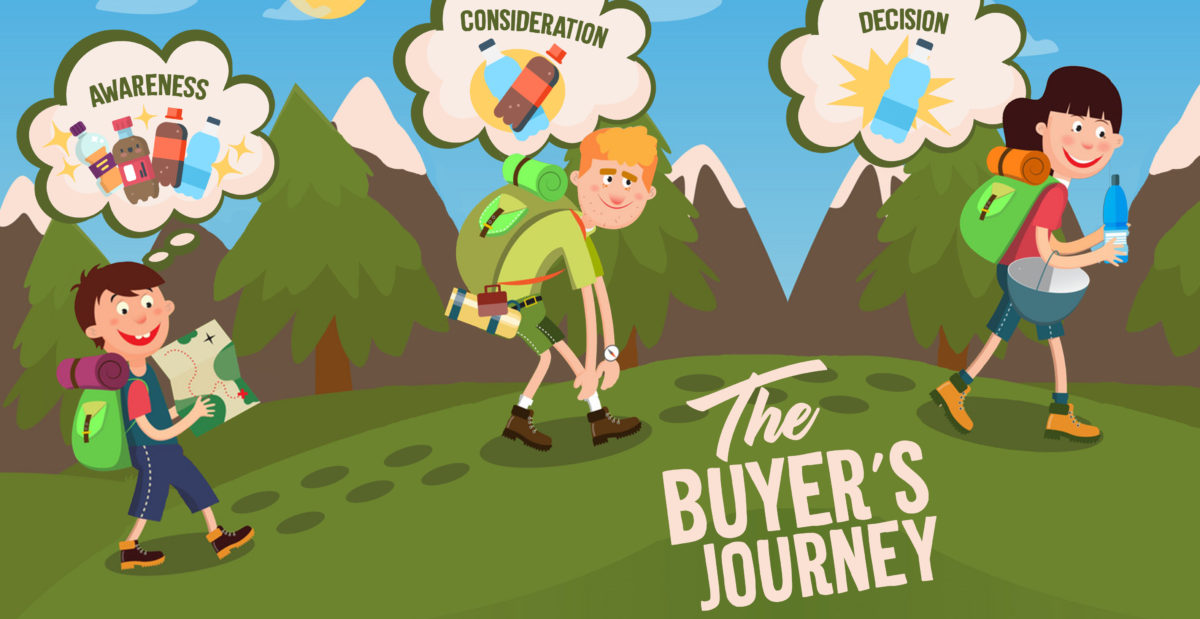With the various competitions here and there, inbound marketers have come to realize that the purchase process is actually a journey. And no, you might be thinking about Star Wars or Justice League with the accompanying images or their misadventures and expedition successes. The characters’ affixing long-tailed missions and ultimate goals in due course — lol no. Corny aside, it is an essential marketing framework most industries acknowledged to dramatically improve ROI.
The buyer’s journey is a funnel-like model which analyzed a buyer’s progression from awareness of a problem to consummating a purchase. This is a marketing strategy that nurtures a prospect towards becoming an actual sale.
What is a Buyer’s Journey?
The buyer’s journey chronicles the process of a buyer from recognizing their problem, searching for possible solutions to purchasing a new product or service to alleviate the dilemma. The journey is consists of three stages: awareness stage, consideration stage and decision/purchase. This model is designed for marketers to understand consumers’ behavior and to formulate equivalent solutions for their marketing efforts.
To influence the research process of your target prospects, creating content that follows the buyer’s journey is the strategy. However, this must be done with the targeted persona in mind for each stage. As a marketer, you have to conceptualize the path your prospects will take for results. With this, researching prospects become familiar with your brand and might find solutions along the journey. Consequently, they will find importance in your contents and you’ll eventually a become a priority in their decision.
To further understand the funnel, here are the three stages of the buyer’s journey:
Awareness Stage (Educating)
In this funnel, a prospective buyer is experiencing a problem that needs to be answered. To elaborate on the dilemma, the prospect is diagnosing it through research by entering search terms in the search engine. In that context, your SEO game plan will come in essential for the marketing plan. It’s time for them to find the answers to the paint points, and as a marketer, it is your job to educate them by positioning your content appropriately.
How to create content for the awareness stage funnel? As mentioned earlier, prospective buyers in this stage are looking for answers to alleviate their pain points. In this stage of the journey, contents must provide information and useful ideas to educate them about the problem. Sales action and business highlights are discouraged to effectively communicate with the prospects. So don’t worry, information pertaining the business products or services can be gradually introduced in the following funnels.
Want some examples? Here are sample blog articles for awareness stage base on the prospective buyer’s queries:
- How to Hire a Virtual Assistant?
- Definitive Guide to Pay-Per-Click Marketing
- What Makes an Outstanding Contact Center Staff?
The content in the above blog articles will provide insights to the readers without getting alienated from the explicit company or sales actions.
Consideration Stage (Evaluation)
From identifying the problem and understanding the bigger picture, prospective buyers in consideration funnel are evaluating various methods helpful to them. In this stage, it is your call to deliver critical and methodical information pertaining to their dilemma. The content you provide should position you in their priority solutions option to obtain trust.
While prospects in the consideration stage are likely to convert as leads, it is imperative to be proactive in delivering quick solutions without alienating them with the company offerings. Here are some sample article titles to qualify your lead for the final funnel.
- Quick APLUS Tips in Working with Virtual Assistant
- Reasons Why You Need Digital Marketing Right Now
- Ideal Content Management System for Startups
Decision Stage (Solution and Purchase)
And here goes the last stage! At this point of the funnel, the buyer has finally determined the exact strategy to address their problem. However, to implement the possible solution, the buyer needs that extra nudge to decide for possible vendors. But wait, don’t get too excited! Yes, it’s your time finally showcase your company products or services, but you have to do it strategically. They key here is to provide content information that centers to the solution for the buyer, not as an information that centralized your sales pitch objectives. Remember, the main goal of the buyer’s journey is to guide the audience in the right decision along the way. As a marketer, it is your job to make them feel secure and confident in their decision. Ultimately, their success purchase is also your success!
Your decision stage blog articles might look like the following:
- Hiring a Virtual Assistant in the Philippines
- Six Reasons Why an APLUS Virtual Assistant is All You Need
- The Outstanding Marketing Team in Mactan Island
A profound understanding of your target personas is critical to success in your marketing. Some marketers failed to comprehend the buyer’s journey and come up with insignificant content marketing efforts. Here’s the catch, if the content doesn’t provide value and information to the prospect buyers, then you’re putting yourself in a problematic situation that could lead to pitfall. Nevertheless, if you try to fit in the shoes of your consumers, then you will see the hindsight and truly perceive if the content is a resource for you.
With a tactical marketing strategy tailored to buyer’s journey stages, you’ll get create content accessible through the right channels. Ultimately, with consistency and determination, the ideal results will conspire in the long run.

